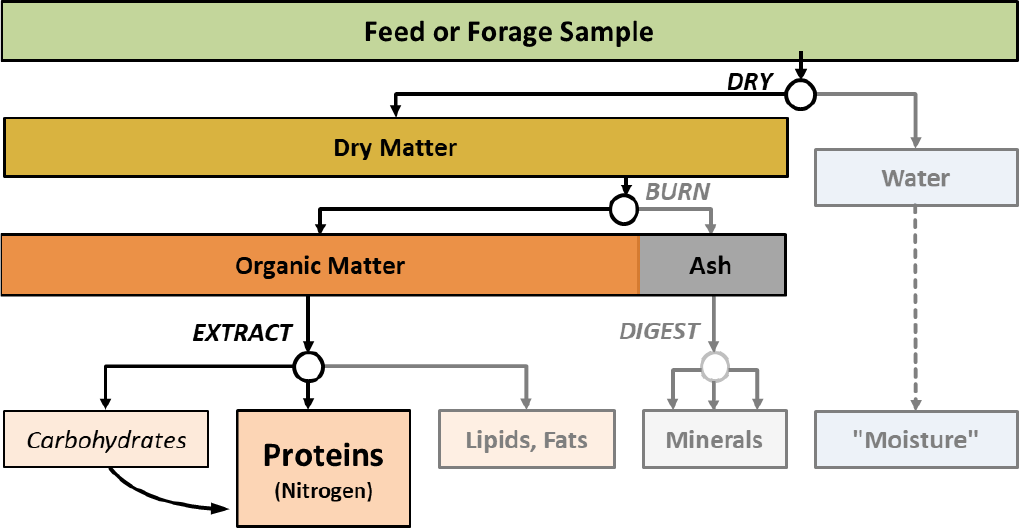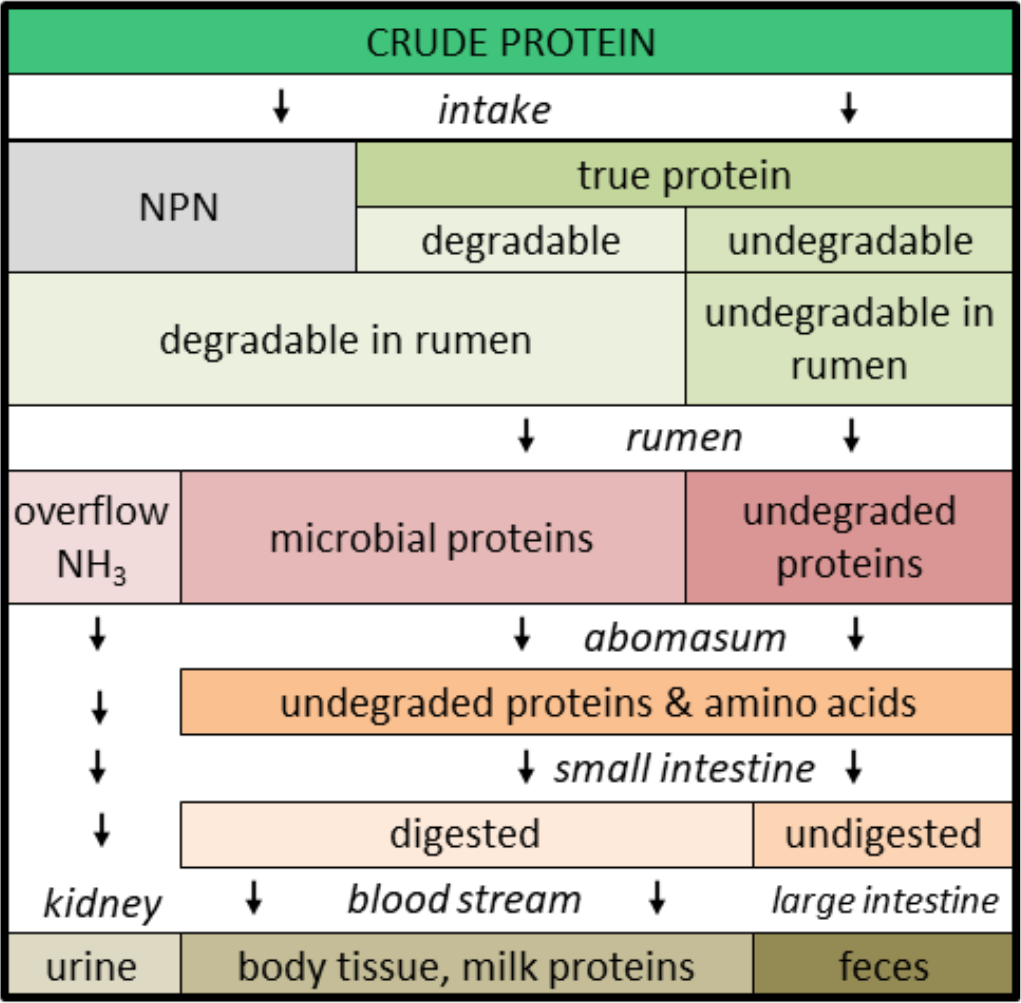⇦ Back to Livestock and Feedstuff Management Home
¶ Introduction
“Crude protein” is a well-known term referring to the nitrogen content of a feedstuff. It probably the most frequently requested feed test. Proteins consist of long, complex chains of amino acids. There are about twenty amino acids that combine like building blocks to construct an infinite range of individual proteins. Feeds also contain a number of nitrogen-containing compounds that are included as “protein”, but these compounds often have different roles in livestock nutrition.
¶ Measuring Protein
The three most common methods for determining nitrogen content (i.e., protein content) are: (1) Kjeldahl digestion, (2) flash combustion, and (3) near infrared spectroscopy.
Kjeldahl digestion was developed in 1883 by a Danish chemist to measure nitrogen in organic substances. The sample is first boiled in a concentrated acid solution at an extremely high temperature to convert the various complex nitrogen compounds (including amino acids) into simple ammonium (NH4). The solution is distilled to convert the ammonium to ammonia (NH3). The gaseous ammonia is captured to measure the nitrogen content.
The method measures nitrogen bound to certain organic components (proteins, amino acids, nucleic acids) and ammonium (NH4). Nitrate (NO3), nitrite (NO2), and certain other nitrogen-containing compounds (e.g., quinoline, pyridine) are not determined.
The Kjeldahl method is widely used and considered the standard for analysis, but it is labor and equipment intensive. The spent acid solution is considered a hazardous waste for disposal purposes.
Flash combustion is used to determine total nitrogen in both organic and inorganic materials. A small amount of sample is dropped into a furnace at 950°C (1700°F) and flushed with pure oxygen. The sample combusts and releases gaseous nitrogen (N2), nitrous oxides (NOx), carbon dioxide (CO2), and hydrogen (H2). This stream of gases is scrubbed and the resulting concentration of gaseous nitrogen is measured by a detector cell.
Combustion nitrogen duplicates well with Kjeldahl nitrogen and can be highly automated. It only generates a small amount of non-hazardous waste. Combustion requires a much smaller sample size, so sample preparation is critical.
Near-infrared spectroscopy (NIRS) is based on the principle that each major organic component of a sample will absorb and reflect near-infrared light differently. The reflected radiation is converted to electrical energy and fed to a computer for interpretation. By measuring these different reflectance characteristics, the NIRS unit and a computer with the proper calibrations can determine the concentration of these components in the feed sample.
¶ Figure 1. Basic Work Flow of Protein Analysis

¶ Crude Protein
Amino acids have an average nitrogen content of about 16%. We estimate the protein content of a feed sample by determining the total nitrogen content with a specific laboratory method. The nitrogen result is multiplied by 6.25 to calculate the crude protein content shown on the analysis report. The 6.25 factor is derived from the formula:
- 6.25 = 100% ÷ 16%
Crude protein analysis assumes that all nitrogen sources are equally effective. The crude protein value simply identifies the portion of the sample that contains nitrogen. It does not distinguish between true proteins (which contain amino acids) and non-protein nitrogen compounds.
Thus, the crude protein test gives equal weight to all nitrogen compounds whether they are or are not digestible. It also does not distinguish the site or extent of digestion for ruminant or monogastric animals
Crude protein test results can be represented by the green stack of blocks to the left in Figure 2. In the picture, all blocks have equal characteristics, the same size and the same color.
The stack to the right in Figure 2 is the same size and shape as the left-hand stack, but is made up of different colored blocks. The different colors represent the concept that crude protein actually consists of different nitrogen compounds with different characteristics.
¶ Figure 2. Representation of Crude Protein

after Heeg, A. 2022. "Reading your forage analysis report"
¶ Protein Systems
There are two systems used to evaluate and balance livestock rations on a protein basis. These are the “crude protein” and “metabolizable protein” systems.
Crude protein system: Crude protein has been the most commonly used system. The crude protein system assumes that all nitrogen in different feeds has similar nutritional value, like the green blocks in Figure 2 left.
It is easy to use and has many reference tables with feed composition and animal requirement information. Research has shown that crude protein alone may be a poor predictor of animal performance.
Metabolizable protein system: Nutritionists have modified the crude protein system to improve performance predictions. The metabolizable protein system is considered to be better able to define protein utilization, thus improving ration formulation.
This system adds protein solubility and rumen degradability as additional factors to consider when using crude protein as a basis when formulating rations. The colored blocks in Figure 2 illustrates the concept of these different protein fractions in the metabolizable system.
Most commercial labs cannot measure the rumen degradability of protein, but there are test procedures that help estimate the potential degradability of certain fractions. The metabolizable protein system depends on computer programs to complete complex calculations and projections of degradability for various feeding situations.
¶ Metabolizable Protein
Metabolizable protein is considered to be the fraction of dietary protein that is available to the animal that includes both the biological crude protein synthesized by the rumen microorganisms and the rumen undegradable protein that is mainly digested in the small intestine
Figures 3 and 4 are schematic diagrams that illustrate protein fractions and nitrogen digestion by ruminant animals. The various terms used in these Figures are described in the following paragraphs.
¶ Figure 3. Schematic Diagram of Metabolizable Protein System Fractions

¶ Figure 4. Schematic Diagram of Protein Digestion in Ruminant Digestive System

¶ Natural or True Protein
“Natural” or “true” protein refers to much of the nitrogen found in forages, grains, and supplements. This protein fraction is found in the various complex and linked structures identified as amino acid combinations.
Some examples of natural proteins are: albumins, globulins, and amino acids. Feeds with natural proteins will vary in both the rate and extent of degradation that occurs in the rumen.
¶ Non-Protein Nitrogen (NPN)
Non-protein nitrogen (NPN) compounds do not have an amino acid profile, but can be used as nitrogen source by ruminal microorganisms. NPN cannot be used as a protein source by monogastric (single-stomached) livestock.
It is typically found as simple compounds, including urea (CO(NH2)2), ammonium (NH4), ammonia (NH3), or nucleic acids. These non-protein compounds are quickly degraded and converted into microbial protein by the rumen microorganisms.
The level of non-protein nitrogen that an animal can utilize depends on the livestock type, production level desired, and type of ration.
NPN sources are used in ruminant diets for two main reasons:
- non-protein nitrogen adjusts the amount of rumen degradable protein in the diet; and
- non-protein sources (like urea or ammonium sulfate) are less expensive than natural protein sources
NPN has to be determined separately from total protein. It is measured by adding the enzyme "urease" to the feed sample before analysis. Urease converts one molecule of urea into two molecules of ammonia and one molecule of carbon dioxide.
After the conversion is complete, the sample is steam distilled to recover both the ammonia converted from urea and the ammonia already present in the sample. This ammonia-nitrogen content is multiplied by 6.25 to calculate the NPN content as a crude protein equivalent.
¶ Rumen Degradable Protein (RDP)
Rumen degradable protein (RDP) is that portion of the total nitrogen intake that is broken down or degraded in the rumen by microbial fermentation. It may also be known as degradable intake protein (DIP). The NPN fraction is included in this degradable protein fraction.
About 40% to 80% of the ingested protein that enters the rumen is degraded. This fraction provides a mixture of peptides, free amino acids, and ammonia that are used by microorganisms for growth and synthesis of microbial protein.
This microbial protein then passes from the rumen into the abomasum for further digestion and supplies the majority of amino acids that enter the small intestine.
¶ Rumen Undegradable Protein (RUP)
Rumen undegradable protein (RUP) is the portion of the total nitrogen that resistant to degradation by rumen microbes and is mainly digested in the small intestine. This is typically ranges from about 20% to 60% of the ingested protein. It is also called bypass protein, escape protein, or undegraded intake protein. Examples of feeds that contain high RUP concentrations include heat-treated soybean meal and cottonseed meal.
RUP represents the protein fraction that passes intact to the small intestine without any previous modification in the rumen. A portion of the RUP can then be absorbed by the animal’s intestine. The remaining portion is not available to or is not digested in the small intestine, therefore is excreted in the feces.
¶ Microbial Crude Protein
Microbial crude protein is the undegradable fraction produced in the rumen by the rumen microorganisms. The microbes eventually pass out of the rumen and are digested in the small intestine. These microbes are about 10% nitrogen (about 60% to 65% crude protein).
Microbial protein has a high digestibility and can provide 50% to 80% of the amino acids required in the intestine. The quantity of ammonia available in the rumen and the supply of fermentable carbohydrates to provide an energy source are key factors that govern microbial protein synthesis.
¶ Acid-Detergent Insoluble Nitrogen (ADIN)
Acid-detergent insoluble nitrogen (ADIN) results from nitrogen that has become chemically linked to structural carbohydrates, primarily cellulose and lignin. It does not contribute to either the rumen degradable or undegradable protein and may be completely indigestible.
ADIN is determined by first extracting the fiber that is insoluble in an acid detergent solution. This insoluble residue is then analyzed for total nitrogen and may be multiplied by 6.25 to provide a crude protein equivalent (acid detergent insoluble crude protein or ADI-CP)”.
The ADIN linkage occurs due to some type of heating and is often called “heat damaged protein (HDP)”. Microbial activity in hay or silage that is harvested too wet may generate heat during storage. The sugars in the forage condense and become syrupy during this heating process. Heat-damaged forages usually have a brown or black color with a sweetish “caramel-like” or “tobacco-like” odor. The ADIN in ingredients like distillers grains may result from heat applied during processing.
Livestock animals will readily consume heat damaged forages because of the smell and taste. However, the protein that is combined with the fiber is unavailable for digestive absorption. Animals may be eating well and analysis of ration crude protein may look adequate, but protein deficiency can occur if a high percentage of the protein is actually heat damaged.
Certain roughages may have a high ADIN content even though they have not been heated. Corn stalks, very stemmy alfalfa, hulls, and similar feedstuffs have a high fiber content. A high percentage of the protein may be naturally combined with the fiber and be unavailable for digestion. High fiber roughages like these should be analyzed for both crude protein and ADIN before feeding.
¶ Adjusted Crude Protein
ADIN is not considered available for digestion, though it is included in the total crude protein measurement. If it is present in significant amounts, the protein content of a ration should be adjusted accordingly when formulating the ration.
Make an adjustment if the ratio of insoluble ADIN fraction (i.e., ADI-CP) to the total crude protein is 0.10 or greater, meaning more than 10 percent of the CP is considered unavailable for digestion.
¶ Neutral Detergent Insoluble Nitrogen
Neutral-detergent insoluble nitrogen (NDIN) refers to nitrogen that has become chemically linked to structural carbohydrates, primarily hemicellulose, cellulose, and lignin. NDIN is determined by first extracting the neutral detergent fiber fraction from a feed sample.
The remaining insoluble residue is analyzed for total nitrogen and may be multiplied by 6.25 to provide a crude protein equivalent. It is often reported as “neutraldetergent insoluble crude protein (NDI-CP)” or “NDF crude protein (NDF-CP)”
A fraction of the NDIN will be both degradable by rumen microbes and digestible in the small intestine. A second protein fraction will be completely indigestible, usually estimated as the ADIN. The degradable/digestible fraction is calculated by difference (digestible-N = NDIN - ADIN).
The NDIN is a portion of the rumen bypass protein. As the fraction of NDIN increases compared to ADIN, the estimate of bypass protein also increases.
¶ Soluble Protein
Soluble protein are nitrogen sources that are most readily available to animals. This is the fraction consisting of small amino acid chains that will solubilize in rumen fluid and be absorbed across the rumen wall. It also includes nonprotein nitrogen sources, like urea.
There is no standard method for determining soluble protein. It is often estimated using in-vitro methods involving liquids like rumen fluid or a pepsin solution. Chemical tests for soluble protein include using a borate buffer solution or a potassium hydroxide solution.
¶ References
Heeg, A. 2022. “Reading your forage analysis report”. published 28 February 2022 in Progressive Forage. accessed 20May2022 https://www.progressiveforage.com/forageproduction/management/reading-your-forage-analysis-report
Parish, J.A. & J.D. Rhinehart. 2018. Protein in Beef Cattle Diets. Pub. No. P2499. Mississippi State University Extension Service. 8 pg.
Rasby, R.J., et. al. 2008. NebGuide G1892 - Understanding and Using a Feed Analysis Report. Univ. of Neb. Coop Ext. accessed 19July2022 https://extensionpublications.unl.edu/assets/html/g1892/build/g1892.htm
Cappellozza, B.I. 2019. A guide to protein nutrition for cattle. Oregon State University Ext. Serv. accessed 22Jul2022 https://extension.oregonstate.edu/animals-livestock/beef/guideprotein-nutrition-cattle